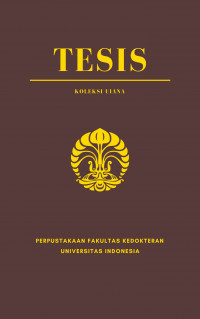Tesis
Perbandingan Uji VereCoV TM Dan Real-Time RT PCR Pada Sampel Pemeriksaan Covid-19 = Comparison of Vercov and Real-Time RT PCR Tests on Covid-19 Examination Samples.
Latar Belakang. SARS-CoV-2 menimbulkan beban yang sangat besar pada masyarakat, sistem ekonomi dan kesehatan di seluruh dunia. Berbagai langkah diambil untuk mengendalikan penyebarannya. Langkah – langkah tergantung pada diagnosis yang tepat waktu dan akurat dari orang yang terinfeksi virus. Penyebaran COVID-19 yang cepat, deteksi virus yang cepat dan tepat memegang peranan penting untuk mengendalikan infeksi dan membantu pasien untuk mencegah perkembangan penyakit lebih lanjut. Metode real-time reverse transcriptase-PCR (rRT-PCR) sangat dianjurkan untuk deteksi SARS-CoV-2 sebagai uji kualitatif spesifik dan sederhana. Selain metode menggunakan rRT-PCR, telah terdapat metode dengan pendekatan yang berbeda untuk mendeteksi SARS-CoV-2. Salah satu metode tersebut adalah VereCoV TM yang memiliki cara kerja berdasarkan teknik PCR dan hibridisasi, namun performa dari VereCoV TM masih belum diketahui. Tujuan. Penelitian bertujuan untuk mengetahui kesesuaian dan kaitannya dengan gejala klinis menggunakan uji VereCoV TM dengan rRT-PCR dalam mendeteksi SARS-CoV-2. Metode. Penelitian ini menggunakan consecutive sampling. Sampel penelitian yaitu sampel swab nasofaring dan orofaring yang diambil kemudian dianalisis di Laboratorium Mikrobiologi Klinik Fakultas Kedokteran Universitas Indonesia. Analisis data menggunakan Kappa Cohen. Selanjutnya, dilakukan analisis data kesesuaian hasil pemeriksaan kedua uji pada pasien dengan gejala dan pasien tanpa gejala. Hasil. Perbedaan positivity rate antara VereCoV TM dan rRT-PCR sebesar 68% menunjukkan bahwa VereCoV™ memberikan hasil negatif palsu. Jika disandingkan terhadap data hasil rRT-PCR, maka ambang batas deteksi VereCoV TM setara dengan nilai Ct < 32 atau setara dengan 118 salinan RNA. Tidak dijumpai reaksi silang dengan beberapa mikroorganise. Konsistensi antara kedua uji ditunjukan oleh koefisien Kappa (=0,609). Hal ini menggambarkan kesesuian yang moderate atau sedang. Analisis lebih lanjut menunjukkan bahwa kesesuaian kedua pemeriksaan meningkat pada pasien yang bergejala (90%), sebaliknya menurun pada pasien tanpa gejala (76,5%). VereCoV TM lebih sesuai digunakan untuk mendeteksi SARS-CoV-2 pada pasien yang bergejala. Hasil negatif pada VereCoV TM tidak dapat mengesampingkan kemungkinan infeksi COVID-19, sehingga perlu pemeriksaan lebih lanjut untuk mendukung diagnosis yang tepat. Kesimpulan. VereCoV™ lebih cocok untuk mendeteksi SARS-Cov-2 pada pasien yang bergejala. VereCoV TM tidak menunjukan adanya reaksi silang dengan beberapa mikroorganisme, yang terdapat pada saluran pernapasan.
Kata Kunci. COVID-19, rRT-PCR, SARS-CoV-2, VereCoV™, Kappa
Background. SARS-CoV-2 places an enormous burden on society, economic systems and health around the world. Various steps were taken to control its spread. These steps depend on timely and accurate diagnosis of the person infected with the virus. The rapid spread of COVID-19, rapid and precise detection of the virus play an important role in controlling infection and helping patients to prevent further disease progression. The real-time reverse transcriptase-PCR (rRT-PCR) method is highly recommended for the detection of SARS-CoV-2 as a simple and specific qualitative test. In addition to the method using rRT-PCR, there have been methods with different approaches to detect SARS-CoV-2. One of these methods is VereCoV TM which has a working method based on PCR and hybridization techniques, but the performance of VereCoVTM is still unknown. Aim. The aim of the study was to determine the suitability and relation to clinical symptoms using the VereCoVTM test with rRT-PCR in detecting SARS-CoV-2. Method. This study used consecutive sampling. The samples of the study was swab samples of the nasopharynx and oropharynx which were taken and analyzed at the Clinical Microbiology Laboratory, Faculty of Medicine, Universitas Indonesia. Data was then analyze using Kappa Cohen. Furthermore, the data analysis of the suitability of the results of the two tests was carried out in patients with symptoms and patients without symptoms. Results. The difference in positivity rate between VereCoVTM and rRT-PCR of 68% indicates that VereCoV™ gives a false negative result. When compared to the rRT-PCR data, the VereCoVTM detection threshold is equivalent to a Ct value < 32 or equivalent to 118 copies of RNA. No cross reactions were found with some microorganisms. Consistency between the two tests is indicated by the Kappa coefficient (= 0.609). This describes a moderate or moderate fit. Further analysis showed that the concordance of the two examinations increased in symptomatic patients (90%), on the contrary decreased in asymptomatic patients (76.5%). VereCoVTM is more suitable for detecting SARS-CoV-2 in symptomatic patients. A negative result on VereCoVTM cannot rule out the possibility of COVID-19 infection, so further tests are needed to support a correct diagnosis. Summary. VereCoV™ is more suitable for detecting SARS-Cov-2 in symptomatic patients. VereCoVTM did not show any cross-reactivity with some microorganisms, which are present in the respiratory tract.
Keywords. COVID-19, Patient,rRT-PCR, SARS-CoV-2, VereCoV™, Kappa
- Judul Seri
-
-
- Tahun Terbit
-
2021
- Pengarang
-
Tubagus Mohamad Kurniadi - Nama Orang
Lie Khie Chen - Nama Orang
Andi Yasmon - Nama Orang
Mardiastuti H. Wahid - Nama Orang - No. Panggil
-
T21437fk
- Penerbit
- Jakarta : Program Pendidikan Dokter Spesialis Mikrobiologi Klinik., 2021
- Deskripsi Fisik
-
xvi, 64 hlm. ; 21 x 30 cm
- Bahasa
-
Indonesia
- ISBN/ISSN
-
-
- Klasifikasi
-
NONE
- Edisi
-
-
- Subjek
- Info Detail Spesifik
-
Tanpa Hardcopy
| T21437fk | T21437fk | Perpustakaan FKUI | Tersedia |


Masuk ke area anggota untuk memberikan review tentang koleksi